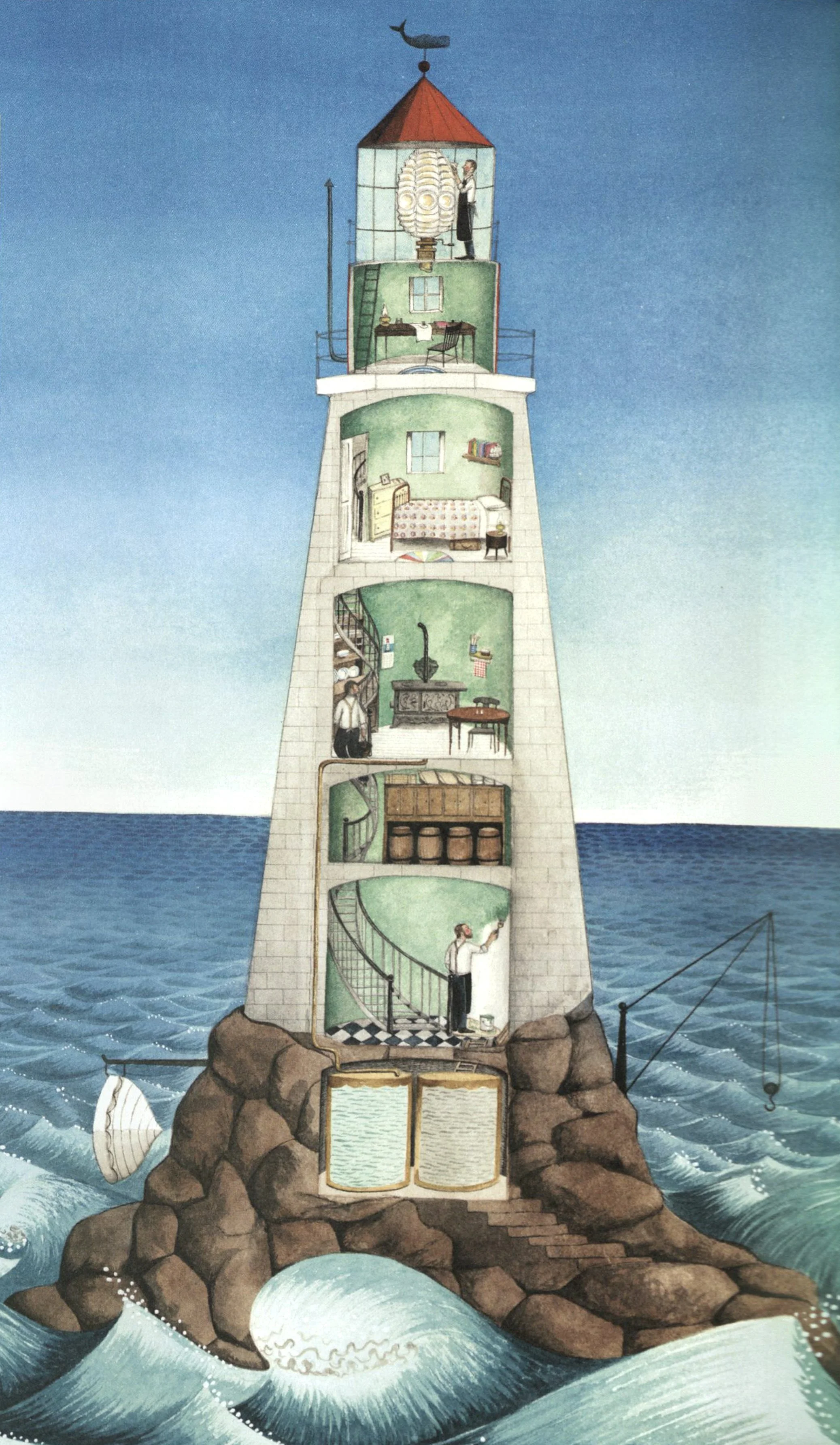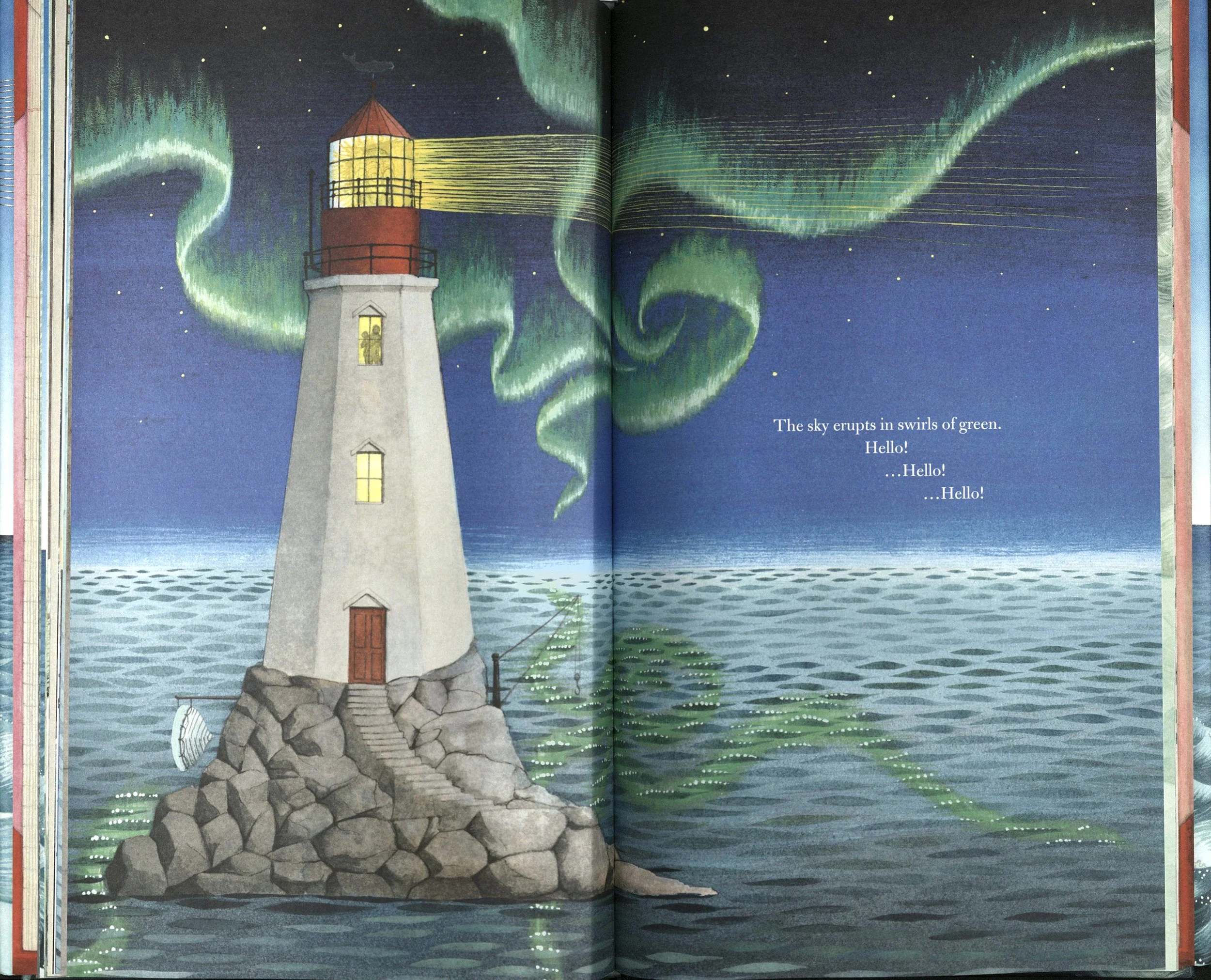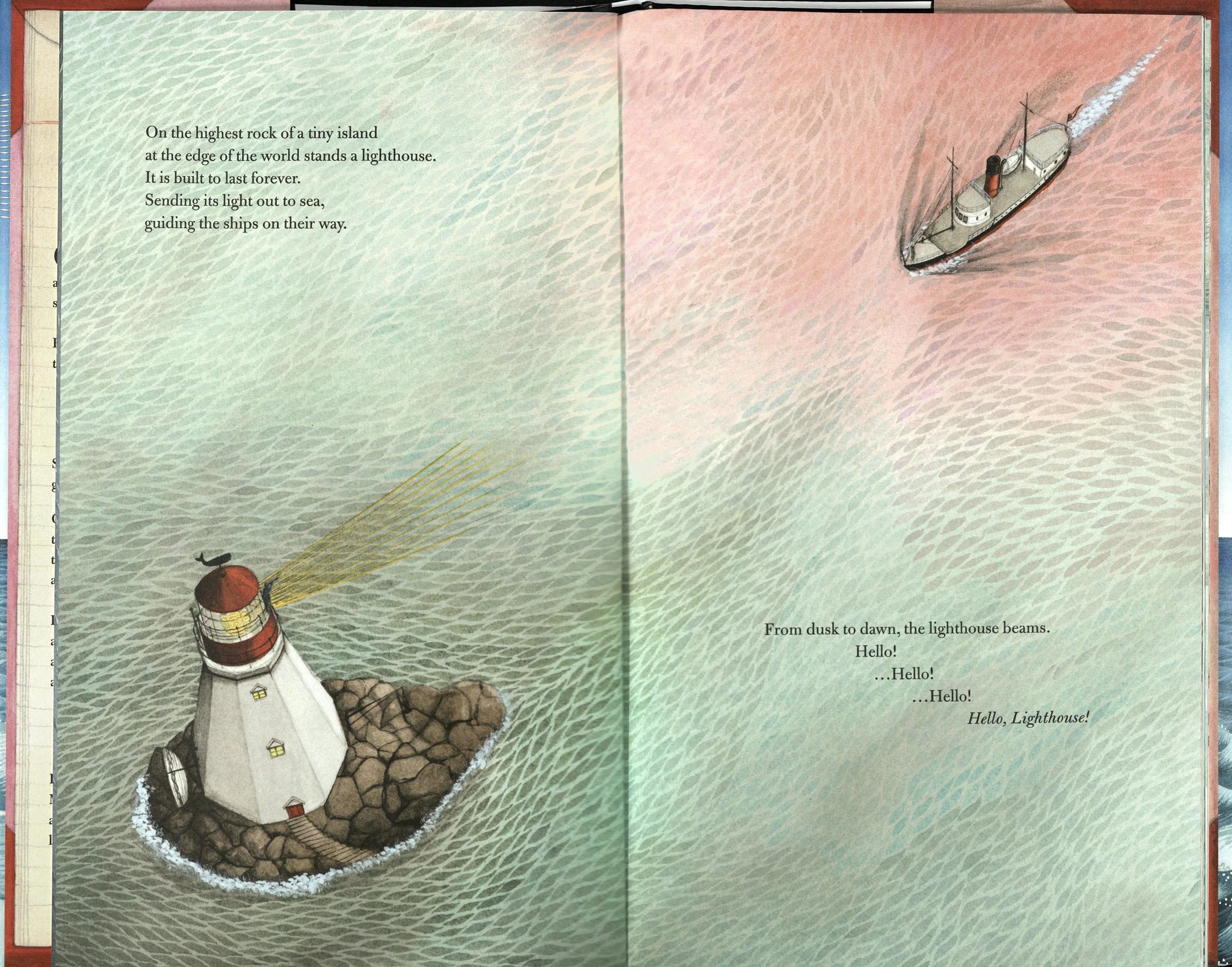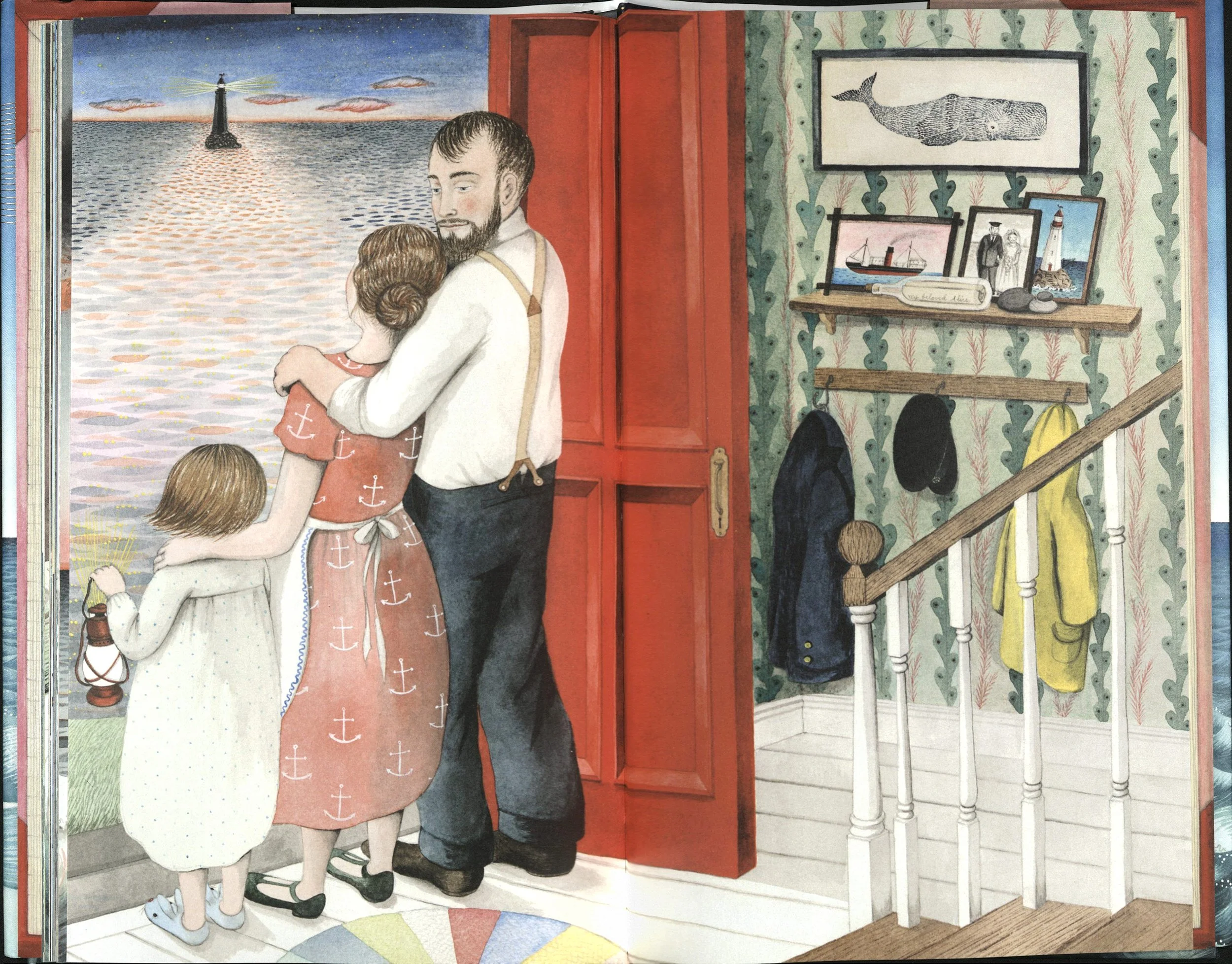Circular Systems in Sophie Blackall's Hello Lighthouse
Hello Lighthouse overflows with comings and goings, in a cyclical celebration of life and its meetings and partings. The story opens as the new lighthouse keeper arrives to replace the one before him, scurrying up and down the spiral staircase painting and polishing, as countless other generations of keepers have done before him. A cutaway illustration of the lighthouse showcases his work—a slice of time in not only his life but the long life of this solitary space. Soon more arrivals grace the island, including his wife ferried in by the supply boat and hoisted up with a hook perched precariously on the edge of the tiny island. The difficulty and arduousness with which life arrives, and sustains itself, on this rocky place foreshadows future hardships and departures in the story of the young couple’s life. An event both laborious and celebratory soon arrives when the lighthouse keeper’s wife gives birth to their child. In a circular vignette surrounded by silverly waves of water that bear life-giving nutrients for both the sea and the young couple, the woman paces concentrically as if marking the hours of her labor. And when the baby finally arrives, the doting father cradles her in his arms, his feet resting on the same braided circular rug that marked the hours when he lay ill. In a cycle of loving give and take, he now sits by his wife’s bedside as she rests under the quilt adorned with vibrant variegated rings, just as she kept watch over him a season before. In a final departure that signals not an end but a new beginning, the book ends with the family’s move to the mainland after the coast guard installs a machine-operated lamp. As the family gazes across the bay at their old home from the front porch of their new one, the circular rug lies at their feet, a constant reminder of the revolutions already traversed and those they will tread tomorrow.
In a round room with sea-foam green walls and a window overlooking a red tinged sea, a woman leans over her husband, pale and sick in their bed. Hot with fever, he has pushed back the delicately quilted blanket revealing its underside full of ghostly florets, round as the room in the lighthouse where he and his wife live. Everything in the small room reflects the round shape of the the lighthouse, from the bowl of broth on the small round table near the wife’s black chair to the lighthouse keeper’s hat atop a dresser with round knobs. The braided rug emerges as the radiant centerpiece of the room—a colorful kaleidoscope in an otherwise somber scene. Its colorful wedges slice the circle into bits of time like intervals on a clock face. While this particular moment for the lighthouse keeper and his wife feels bleak and devoid of color, the circularity of time promises that there are joyful moments ahead—wedges of time that will shine brightly, then pass and melt into the next. The spiral staircase just outside the open bedroom door circles downward promising future seasons of work, growth, and love. In Sophie Blackall’s 2018 Caldecott-winning picture book, Hello Lighthouse, circular symbols prevail, mirroring the cyclical nature of the seasons and life itself in this tale that embraces change but anchors itself in the parts of life that, like a lighthouse, are built to last forever.
The spinning planet and the cyclical seasons those spins bring provide a constantly shifting backdrop to lighthouse life. While the stoic lighthouse remains constant throughout the pages of Hello Lighthouse, the weather shifts frequently immersing the reader in the atmospheric patterns that delight and plague the lighthouse keeper throughout the year. As the book progresses, the lighthouse is surrounded by whipping spring winds, battered by the crashing waves of a brooding summer storm, shrouded in a thick late season fog, and sealed in a polished shelf of ice. The shifting seasons and surf bring visitors, including speckled seals that slither on the ice, migrating whales that navigate looming ice bergs, and even three sailors shipwrecked on the rocks during a dark and stormy night. When the northern lights flicker into the night sky on a clear cold evening, they scatter shimmering circular pearls of reflections on the sea. When time comes for the family to leave the lighthouse, the weather protests, thickening into a brooding overcast sky. But all somber moods, like somber days, lift and pass on into the past, giving way to jubilant sunsets and sparkling star-filled nights. By book’s end, the lighthouse looks radiant once more, surrounded by delicate clouds wrapped in the fading sun’s orange rays. Just as on dry land, in the lighthouse, the seasons’ change marks a circular march around the sun that promises to repeat forever, just as the lighthouse beam burns brightly in its slow steady spins. But with each revolution, predicable and constant, change is revealed. A child grows from a baby to a little girl who stands as tall as her mother’s waist. A world becomes more modern with electricity that replaces hard labor and sweat. And a family watches a beloved home shift from the tangible present to a corner of their minds. But the lighthouse, the physical embodiment of all that remains constant in this world—love, struggle, memory—stays steady.
Circles weave their way into not only the pictures of Hello Lighthouse, but also into the text. The narrative begins and ends in much the same way—by informing the reader of the stability of the lighthouse. “On the highest rock of a tiny island at the edge of the world stands a lighthouse,” says Blackall. “It is built to last forever.” Beginning and ending the narrative with these exact same words reinforces the repetition and circularity featured so heavily in the illustrations and provides a sense of security and safety amongst the many changes that both the lighthouse and its family face throughout the story. In a process that Barthes calls “relaying” the text also takes on new meaning in response to the pictures that the words alone could not convey. Trios of words adorn the text frequently, usually repetitions of the word “hello” which accompany each exterior illustration of the lighthouse. On its own, repetitions of words in picture books usually evoke echos, but because of the presence of the illustrations full of circular motifs, the reader interprets these trios differently. The prominent beam of the lighthouse lamp, which always sits opposite these lines of the book, reveals that the repetitions are revolutions as the light scans the horizon and then repeats again. The little house on the opposite side of the bay at the end of the book returns the lighthouse’s illuminated greeting as the light from the little girls’ lamp shines a hello in return. The lighthouse only fails to greet the reader with a trio of “hello”s during a thick fog mid-story that even its powerful lamp cannot penetrate. Instead, three “clang”s ring out. These repeated phrases become the lighthouse’s way of speaking to the reader—a language decoded in Blackall’s beautiful pictures.
All well-written picture books come full circle. Beloved books in childhood become treasured keepsakes as those children grow into adults, and eventually, turn into bedtime stories for the next generation of children who seem to never tire of reading the same book over and over again, in endless circles. Hello Lighthouse is destined to be one of those passed down books. Its evocative language and bright illustrations full of color and texture will surely enchant any child, while adults will appreciate Blackall’s nods to the nostalgia of time gone by and her reliance on historical research. The back end papers recount Blackall’s visits to several lighthouses to gather relevant details about life of a keeper while making the book. She infuses her illustrations with the the findings she collected, down to the minute details of the objects that adorn the desks and walls of a lighthouse. She laments that the age of the lighthouse has come to an end, but reassures readers that “the stories shine on”. Thanks to Hello Lighthouse and its cyclical rhythms, they surely will.






